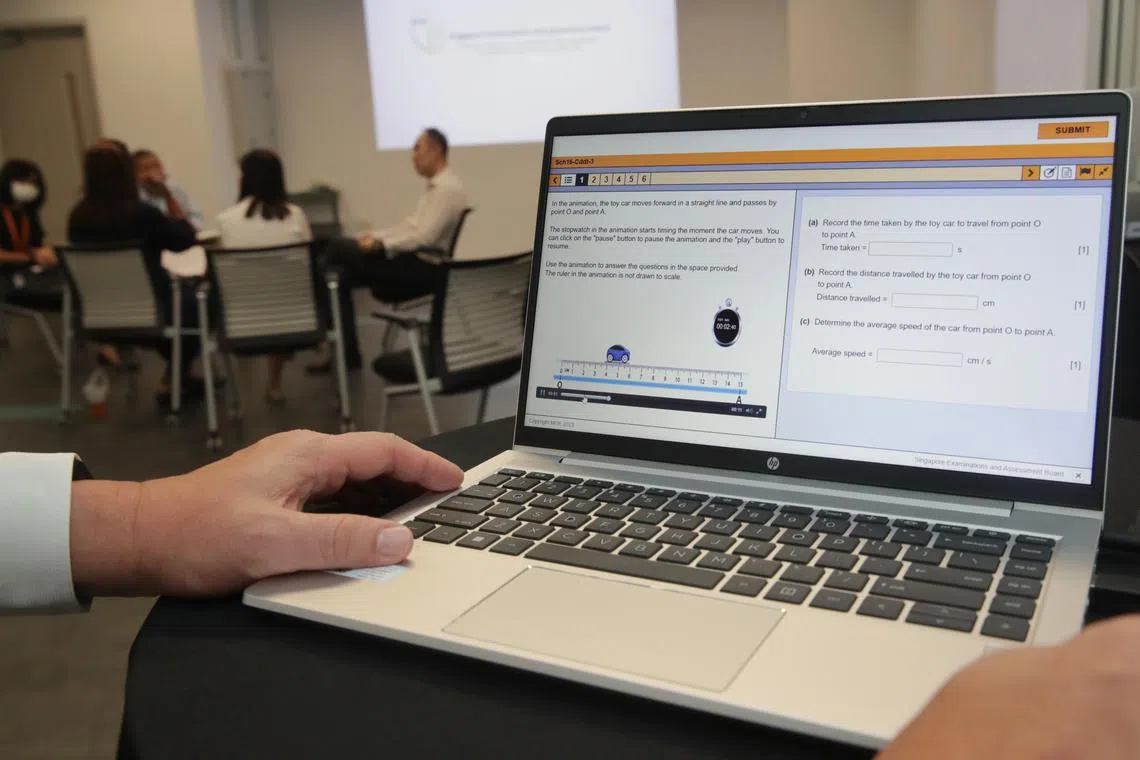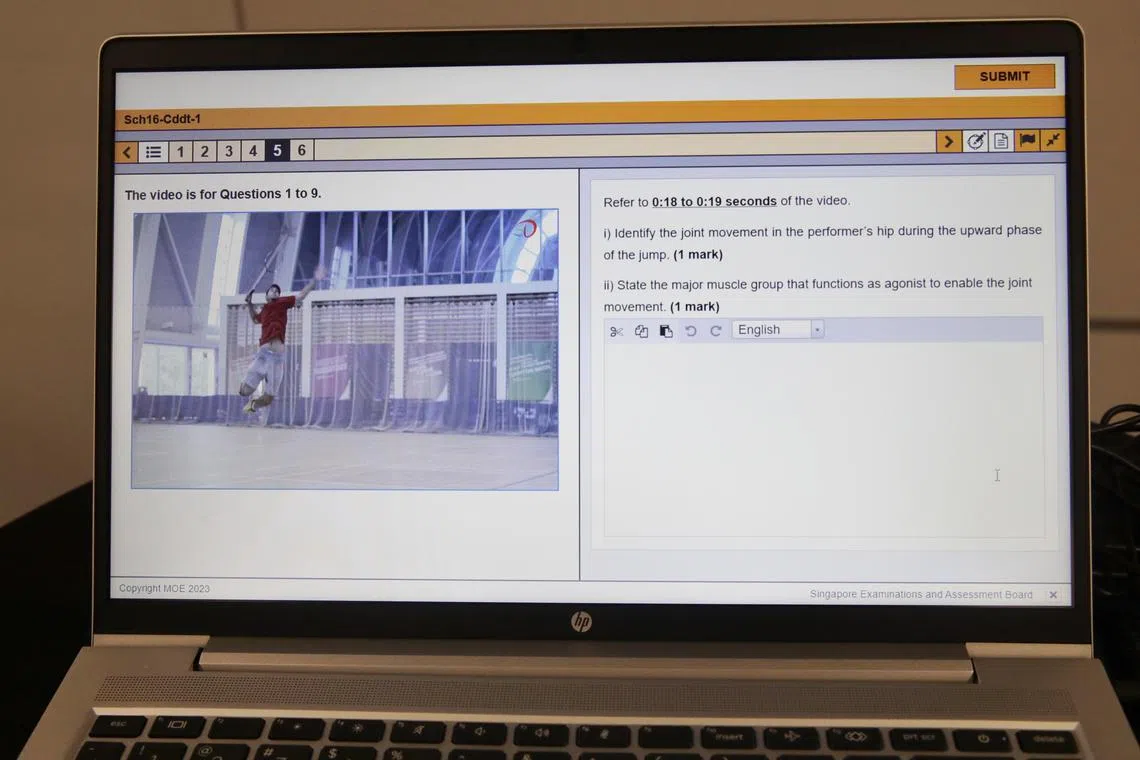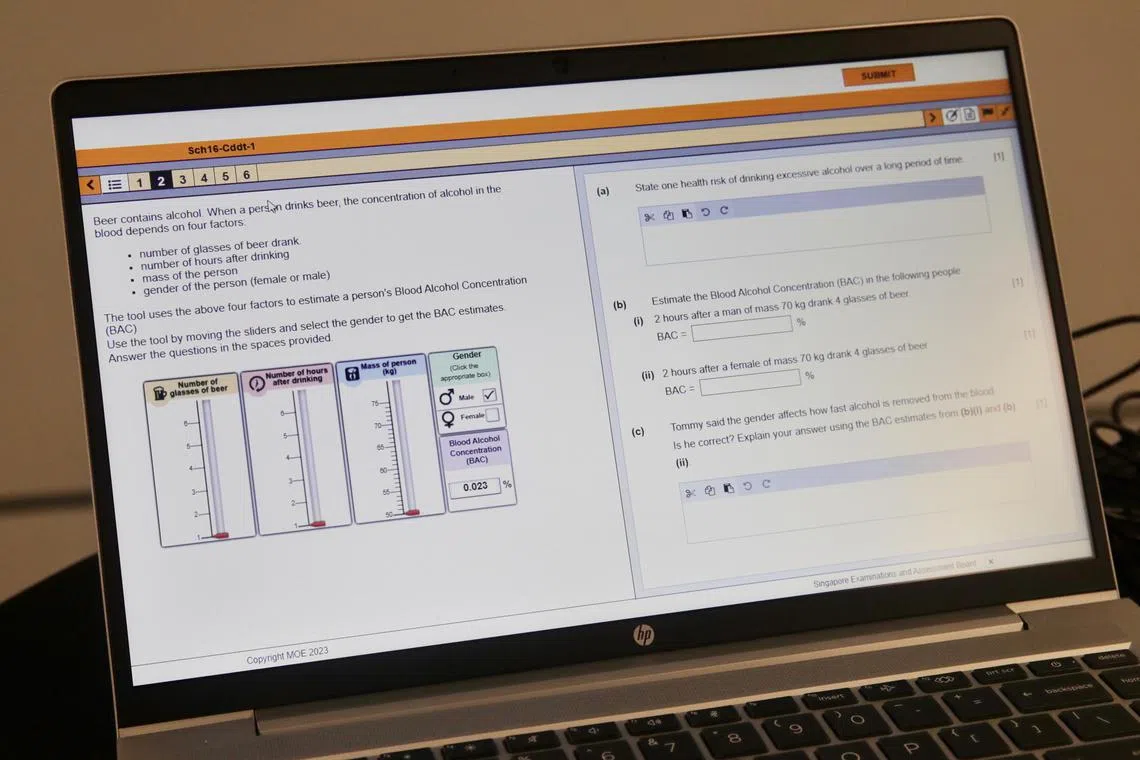Laptops replace pen and paper as S’pore shifts towards electronic examinations
Sign up now: Get ST's newsletters delivered to your inbox

To date, 60 GCE examination papers are now in electronic mode, and conducted in different modes such as e-oral and computer-based practical.
ST PHOTO: GIN TAY
Follow topic:
SINGAPORE - Traditional pen-and-paper exams are gradually making way for electronic examinations, or examinations that are delivered through an online system.
In Singapore, e-exams for national examinations such as the General Certificate of Education (GCE) were first introduced in 2013
To date, 60 GCE examination papers are now in electronic mode. These e-exams are conducted in various modes, such as e-oral, e-written, computer-based practical and e-coursework.
A spokesman for the Singapore Examinations and Assessment Board (SEAB) told The Straits Times that such exams “align the ways students apply and demonstrate their learning in national examinations with the developments in curriculum and pedagogy”.
He added: “(E-exams) support the development of competencies that students would need in their daily lives and the future workplace.”
The Ministry of Education (MOE) has identified a list of 21st-century competencies that will prepare students for the globalised world they live in.
Competencies such as critical and inventive thinking, said SEAB, are better assessed through e-exams through the use of multimedia, compared with pen-and-paper examinations.
Also, in 2021, the introduction of the Personalised Digital Learning Programme ensured that every secondary school student owned a school-prescribed personal learning device (PLD).
This necessitated a shift in the way lessons are designed and enacted so that students would make use of their PLDs in their classroom learning.
Each e-exam mode has innovative features that provide an engaging examination experience. For some examinations, it will also be easier for candidates to edit and organise their responses.
For example, this year’s GCE Normal Technical, or N(T), English Paper One assessment will be an e-exam. Candidates will type their responses for the situational and continuous writing tasks.
They can also make use of the editing features – cut, copy and paste functions – and not have to worry about untidy cancellations or illegible handwriting.
Furthermore, in the GCE A-level H2 Translation (Chinese) e-exam which was introduced in 2022, students can make use of the annotation functions – highlight, bold and underline – and editing tools to do text translation, error analysis and comparative criticism of different translated texts more effectively.
It mirrors real-life translation work and makes the assessment more authentic, said SEAB.

Journalist Elisha Tushara (right) attending a demonstration session by the Singapore Examinations and Assessment Board on June 22.
ST PHOTO: GIN TAY
Another aspect of e-exams is the introduction of multimedia such as videos, animations and interactive simulations (VAI).
The upcoming 2024 N(T)-level Science Paper One e-exam will be the first science subject in Singapore to have computer-based components in its assessment.
In Section A of the paper (comprising 30 multiple-choice questions), questions will feature stimuli such as pictures, graphs and diagrams, which can be in colour.
For example, a pictorial stimulus could be an actual photograph of a hair dryer in colour, instead of a black-and-white drawing on paper.
In Section B (comprising selected response, short-answer and structured questions), questions will be embedded with VAI.
For example, instead of describing an experiment involving litmus papers in a question, candidates will be able to watch a video of the experiment, and replay it as often as they require using the video controls before they answer the question.
The use of multimedia allows questions to be set with authentic and real-life contexts, which test important disciplinary knowledge and skills.
It would be difficult to set similar questions in a pen-and-paper format.
To prepare schools for these changes, SEAB and MOE worked closely to plan and execute the training that teachers would need to support them in their adoption of these examination modes.
A spokesman for SEAB said: “MOE and SEAB support schools with relevant e-learning resources via the Student Learning Space, specimen examination papers and practice sessions.”
It also arranged for students to familiarise themselves with the SEAB eExam System before they sat the national examinations.
Apart from the engaging features, e-exams make assessments more accessible for students with disabilities.
One example is candidates who require larger font sizes due to their visual impairment. This can be facilitated through the use of zoom and text-to-speech software in e-exams.
Such exams also boost efficiency by removing certain administrative processes in paper-based examinations. These include printing question papers, transporting them to and from examination venues, and collecting and counting them at the end of an examination.

One aspect of e-exams is the introduction of multimedia such as videos, animations and interactive simulations.
ST PHOTO: GIN TAY
That said, the adoption of e-exams presents some challenges.
Technical issues, such as Internet connectivity problems or computer glitches, can disrupt the examination experience.
To address this, an SEAB spokesman said there are “resiliency features to safeguard examination candidates’ responses”.
One of these is an automatic save function at multiple locations, including candidates’ laptops and the government cloud, during the e-exams. If there is a disruption, candidates’ responses can be restored easily.
Should there be a network or power failure, candidates can continue their examination on laptops with battery packs.
SEAB told ST that network security measures are also in place to restrict access to only the required secured e-exam system URLs.
Students will not be allowed to access other websites during an e-exam in order to preserve the credibility of the assessment process.

Resiliency features to safeguard examination candidates’ responses, such as automatic save functions, have been included to mitigate technical issues.
ST PHOTO: GIN TAY
Moving forward, more pen-and-paper examinations will be converted to e-exams at a measured pace.
The SEAB spokesman said: “Each change is carefully considered and effected. SEAB works closely with MOE and schools to carry out extensive research with pilot schools to explore how technology can add value to assessment and to ensure the e-exam is manageable and accessible for all students.”
For now, national examinations for secondary schools and junior colleges will feature a blend of electronic and paper modes.
One reason is that for subjects like mathematics, which require simple workings, calculations and drawings, candidates’ understanding and application of concepts are more readily demonstrable on paper.


